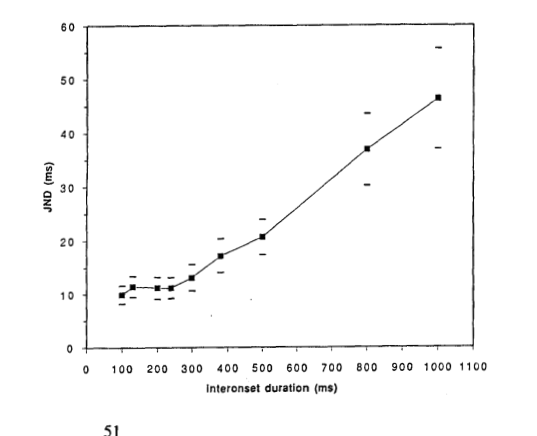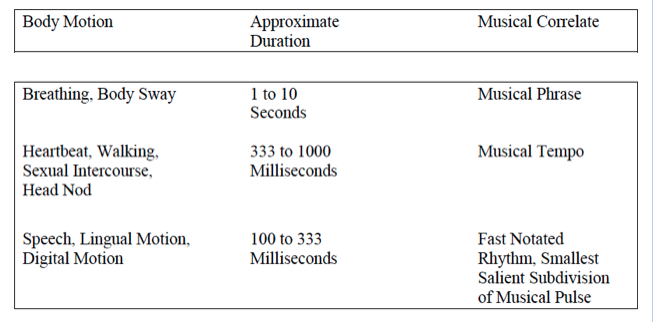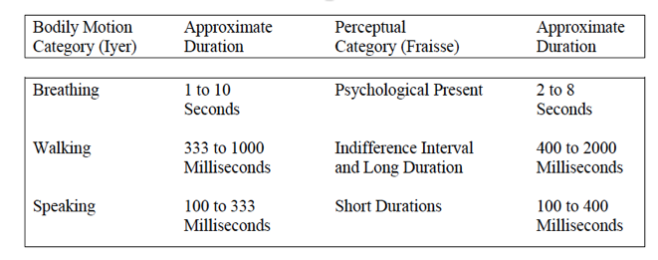The first track from Bohren & der Club of Gore’s album ‘Piano Nights’ exemplifies this peculiarly murky region in our perception of rhythm.
It resides somewhere where we know there is a rhythmic pattern with a specific BPM, but somehow it feels slow to the point where the rhythm begins to be perceived a mere succession of transients that exist outside of meter.
This phenomenon has to do with our brain’s thresholds for the perception of rhythms.
These thresholds are most obvious when we move in rhythmical opposite direction, that is, faster.
-
A great example of this phenomenon is Dan Tepfer’s experiment using the program ‘Supercollider’. We perceive a two voice complex rhythm sped up continuously, morphing into an indistinguishable buzzing, and ultimately to a pitched interval depending on the ratio between the two voices of rhythm.
http://dantepfer.com/blog/?p=277
-
Using the formula F=1/T we can see that once the time difference between successive beats become 50ms or less we enter into the audible frequency domain i.e. 20HZ.
And what Dan shows us is how different complex rhythms depending on their ratios to one another, create intervallic relations in the frequency domain when sped up to the nth degree.
An important term when speaking about the thresholds of rhythmic perception, the interonset interval, or IOI, is the time between the beginnings or attack points of successive events/notes; or the interval between onsets, not including the duration of the events.
The upper limit of discrimination for rhythm is at 100ms [600bpm] – this limit can be accurately discriminated as beats and produced by humans as seen in this epic rendition of ‘flight of the bumblebees’. (@5:21)
-
However, what disappears at this limit is the perceptual curiosity known as ‘subjective rhythmitization’.
This is the phenomenon that occurs when listening to a monotone metronome sequence and the listener begins to perceive some sounds as accented.
In order for rhythmic events to be perceived as beats and contain a ‘strong-weak’ relationship that composers often utilize, the IOI’s then must be no more then 200ms or 300bpm.
This example is a snare drummer playing at this threshold (@0:45).
Notice your ability to feel strong-weak beat relationship and to define a meter if you so choose.
Below are two other examples, which convey prominent strong-weak beat relationships in music.
[@ 0″30′ ]
-
Now getting back the lower end of the rhythmic spectrum.
French Psychologist Paul Fraisse through a series of tapping experiments conducted on human subjects – he found that above 1800ms this subjective rhythmitization becomes impossible because successive sounds no longer are perceptually linked.
This prevents us from hearing such sounds in terms of a coordinated motion or movement.
So then 33 bpm, approximately 1800ms, exists as the limit of subjective rhythmitization. A musical application of this threshold can be heard in this track by Donny Hathaway’s ‘I’ll love you more then you’ll ever know’.
We are still able to perceive beats as having a strong-weak relationship here, but it feels almost as if we were teetering on the brink of the music collapsing in on itself.
As soon as we dip below 33bpm as in the case of Bohren & der Club of Gore’s Piano Nights, which is at approximately 22bpm, the rhythmic movement in the music begins to feel strange to our ears.
-
Like the upper limit of rhythmic perception, where rhythm below 100ms can no longer be distinguished – there’s a similar, but more imprecise equivalent in the lower limit of perception referred to as the ‘perceptual present’.
It is defined as “ the temporal extent of stimulations that can be perceived at a given time, without the intervention of rehearsal during or after the stimulation”.
So in this time frame – an IOI literally becomes a memory before the next transient, and in order to have any sense of rhythm – the brain has to recall a past event, a neural activity, which isn’t necessary in the frame of subjective rhythmitization.
This perceptual present ranges from about 2 to 6 seconds.
The reason the range of the perceptual present then is so great is due to the murkiness of rhythm at these ‘grave’ IOI’s. While Paul Fraisse’s tapping experiments concluded this limit to be 1800ms, music is not ‘metronomical’ in nature.
If we listen to the same Bohren song from the beginning but slow it down to half as fast, the rhythmic events venture even deeper outside of the limits of the perceptual present.
(Use youtube to slow down the first link to half speed)
The music of Morton Feldman often dabbles in the outskirts of the perceptual present as in the piece ‘For Frank O’Hara’
-
Similar to the frequency domain – there are Just Noticeable Difference, or JND’s, within our rhythmic perception.
The boundaries of the perceptual present correspond to a qualitative shift in our perception of rhythm and musical time.
For example, Fracoise Macar has found that listeners are much less sensitive to changes in duration for time spans lasting 4 seconds or longer.
The table below contains observable JND’s in accordance with varying tempi increasing or decreasing.

In a study conducted by Fridberg and Sundberg, subjects were asked to adjust a rhythmically out of place beat in a steady sequence. “The average JND was found to be about 10 ms for tones shorter than about 240 ms durution and about 5% of the duration for longer tones.”
This figure represents gleaned JND’s of the experiment as a function of time.

A link between these thresholds of rhythmic perception and biological evolution also exists. .
Our conceptual systems are grounded and structured by sensory process i.e. perception and motor processes i.e. action, since these processes evolved in simultaneously they are fundamentally inseparable and mutually informative.
Therefore, it is plausible to speculate our ability to feel and recognize rhythms is defined by our motor capacities, and to design a model of rhythm perception based around the idea of a sensory-motor filter.

And in accordance with Fraisse’s models of perception:

It is important to note the heuristic nature of human mechanisms in understanding sonic stimuli. Therefore, in determining such limits it is crucial to operate with widely vary methods of gathering data. Lehman suggests that perception research of music should be viewed not as theoretical models then, but “as a collection of heuristics that may provide useful and meaningful approaches to rhythm in music composition.”
These strikings instances of similarity highlight the intrinsic interconnectivity between the origins of our organs and modes of perception and evolutionary bodies.
Music, therefore, as a whole resides in our brains, as a psychological consequent, which taps into a small window of the physical world where longitudinal waves traveling at precisely right speed and are transformed in ringing harmonies, and clanging repetitions within a precise time frame propel us to move in synchronization.

